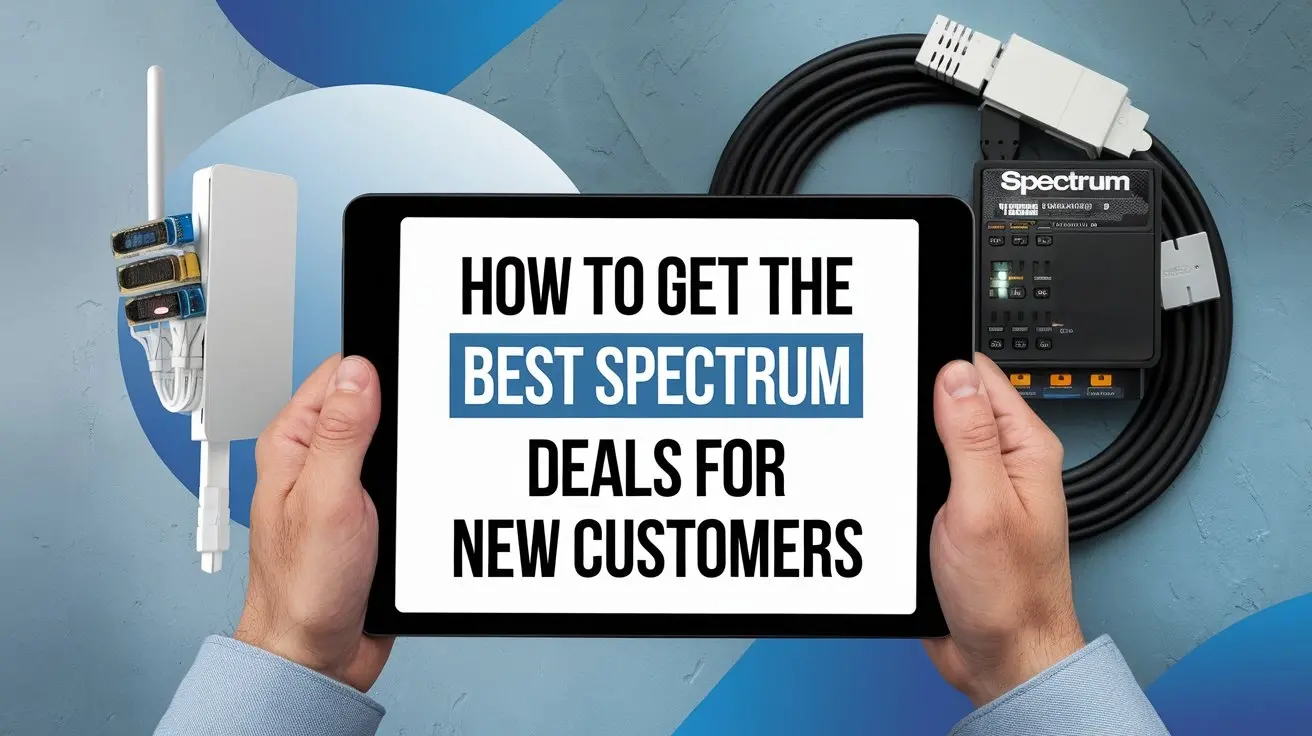Why are people leaving Spectrum?

Many Spectrum customers are exploring alternatives due to rising costs, inconsistent service, and a desire for better value. This guide delves into the primary reasons behind customer departures, offering insights and potential solutions for those considering a switch from Spectrum services.
Key Reasons Spectrum Customers Are Switching
The landscape of home internet, TV, and mobile services is constantly evolving, and with it, consumer expectations. Spectrum, a major player in the telecommunications industry, faces a growing number of customers re-evaluating their subscriptions. While Spectrum offers a wide range of services and a significant presence across many U.S. markets, several recurring themes emerge when examining why individuals and households decide to leave. These reasons often stem from a combination of economic pressures, service performance issues, and the increasing availability of more attractive alternatives. Understanding these drivers is crucial for both consumers contemplating a move and for Spectrum itself to address potential churn.
In 2025, the primary motivations for leaving Spectrum can be broadly categorized. These include the persistent issue of escalating prices, particularly after promotional periods expire, and concerns regarding the actual quality and reliability of the internet and TV services provided. Furthermore, customer service interactions, or the lack thereof, frequently play a pivotal role. The competitive market also presents compelling reasons to switch, with new technologies and service models emerging that offer greater flexibility, speed, or value. This comprehensive exploration will break down each of these factors, providing a detailed look at the forces compelling people to consider alternatives to Spectrum.
The Escalating Cost of Spectrum Services
One of the most frequently cited reasons for customers leaving Spectrum is the rising cost of their services. This is not unique to Spectrum; many telecommunications companies employ a strategy of offering attractive introductory pricing to new customers, only to see those rates increase significantly once promotional periods conclude. For Spectrum, this often means that the monthly bill can jump by tens, or even hundreds, of dollars after the initial contract or promotional period ends.
The "Introductory Rate" Trap
Many Spectrum internet and TV packages are marketed with enticing low prices for the first 12 or 24 months. While this can make a service seem affordable upfront, it often leads to sticker shock when the regular, non-promotional rate kicks in. For example, an internet plan that starts at $50 per month might jump to $85 or $95 per month after the introductory period. This sudden increase can be a significant burden, especially for households on a fixed budget or those who are already feeling the pinch of inflation on other essential goods and services.
Impact of Inflation and Economic Conditions
In the current economic climate of 2025, where inflation has impacted various sectors, consumers are more sensitive than ever to discretionary spending. Services like cable TV and high-speed internet, while essential for many, are often the first to be scrutinized when budgets tighten. The substantial price hikes after introductory offers can make Spectrum's services appear less competitive compared to other providers or alternative entertainment and communication methods.
Hidden Fees and Surcharges
Beyond the advertised monthly price, Spectrum's billing statements can sometimes include a labyrinth of fees and surcharges that further inflate the total cost. These can include:
- Broadcast TV fees
- Regional Sports fees
- Equipment rental fees (modems, routers, cable boxes)
- Taxes and government surcharges
While these fees are common across the industry, their cumulative effect can be substantial. Customers often feel blindsided by the final bill, which can be considerably higher than what they initially anticipated. The lack of transparency or clarity around these additional charges can lead to frustration and a perception that the company is not being upfront about the true cost of its services.
Bundling vs. Unbundling Value
Spectrum often encourages customers to bundle services – internet, TV, and mobile – to receive a discount. However, for some users, this bundle might include services they don't fully utilize or need. For instance, a customer who primarily streams content online might find the extensive cable TV package included in a bundle to be an unnecessary expense. When breaking down the cost per service, the bundled price might seem reasonable, but if individual components are not valued by the user, the overall perceived value diminishes. This leads to the desire to unbundle and pay only for what is truly needed.
Comparison of Introductory vs. Regular Pricing (Illustrative Example - 2025 Data)
To illustrate the pricing issue, consider the following hypothetical scenario for a mid-tier internet and TV bundle:
| Service | Introductory Price (12 Months) | Regular Price (After 12 Months) | Difference |
|---|---|---|---|
| Spectrum Internet Ultra (400 Mbps) | $65.00/month | $95.00/month | +$30.00/month |
| Spectrum TV Select (Standard Channels) | $75.00/month | $110.00/month | +$35.00/month |
| Total Bundle (Hypothetical) | $140.00/month | $205.00/month | +$65.00/month |
Note: These figures are illustrative and actual prices vary by region and specific package.
This significant jump in monthly cost is a major driver for customers to actively seek out providers offering more stable or lower regular pricing. Many competitors may not have such steep increases after introductory periods, or they might offer more competitive regular rates for comparable services.
Concerns Over Service Quality and Reliability
Beyond the price tag, the actual performance of Spectrum's services is a critical factor for customer satisfaction. While many users have a positive experience, a significant portion report issues with internet speed, stability, and TV service disruptions. These problems can range from minor annoyances to major inconveniences that impact daily life, work, and entertainment.
Internet Speed and Consistency
Advertised internet speeds are often the maximum theoretical speeds, and actual performance can vary considerably. Customers often report experiencing speeds that are consistently lower than what they are paying for, especially during peak hours when network congestion is high. This can lead to slow loading times, buffering during streaming, and difficulties with online gaming or video conferencing. For remote workers and students, inconsistent internet speeds can be particularly disruptive.
In 2025, with the increasing reliance on high-bandwidth applications, the demand for stable and fast internet is paramount. When Spectrum fails to deliver consistent speeds, customers begin to question the value proposition, especially when other providers might offer more reliable performance in their area.
Factors Affecting Internet Performance
- Network Congestion: In densely populated areas, Spectrum's shared cable network can become congested, leading to slower speeds for all users.
- Equipment Issues: Outdated or malfunctioning modems and routers, whether provided by Spectrum or the customer, can significantly impact speed and stability.
- Home Network Setup: The internal wiring and Wi-Fi setup within a customer's home can also create bottlenecks.
- External Factors: Weather, construction, or issues with Spectrum's local infrastructure can also cause temporary outages or slowdowns.
TV Service Reliability and Channel Selection
For Spectrum's TV services, issues can include pixelation, frozen screens, audio problems, and complete service outages. While these can sometimes be attributed to local cable issues or equipment problems, some customers report recurring problems that are not adequately resolved by technical support.
Furthermore, the perceived value of Spectrum's TV packages is often tied to channel selection. As streaming services offer vast libraries of on-demand content and a la carte channel options, traditional cable packages can feel outdated and restrictive. Customers may find that they are paying for numerous channels they never watch, while missing out on specific niche content or live sports that are now more easily accessible through other platforms.
The Shift Towards Streaming
The continued rise of streaming services like Netflix, Hulu, Disney+, Max, and YouTube TV has fundamentally changed how people consume television. Many consumers are opting to cut the cord from traditional cable providers like Spectrum in favor of these more flexible and often more cost-effective streaming solutions. This trend means that the value proposition of a comprehensive Spectrum TV package is diminishing for a growing segment of the population.
A common scenario in 2025 involves customers keeping Spectrum for high-speed internet but ditching their TV service in favor of a combination of streaming subscriptions. This unbundling strategy allows them to curate their own entertainment experience and often results in significant monthly savings.
Customer Service Experiences and Dissatisfaction
The quality of customer service is a critical, yet often overlooked, factor in customer retention. When customers encounter problems with their Spectrum services, their experience with the company's support channels can either solidify their loyalty or push them towards seeking alternatives.
Long Wait Times and Ineffective Solutions
Many Spectrum customers report experiencing excessively long wait times when trying to reach customer support, whether by phone, chat, or in person. Once connected, they may encounter representatives who are unable to resolve their issues, leading to multiple calls and a feeling of being passed around. This can be particularly frustrating when dealing with urgent problems like internet outages.
The effectiveness of the solutions offered is also a point of contention. Sometimes, customers are advised to perform basic troubleshooting steps they have already tried, or they are offered temporary fixes that do not address the root cause of the problem. This can lead to a cycle of repeated issues and escalating frustration.
Technician Visit Experiences
When technical issues persist, a technician visit is often required. While many Spectrum technicians are professional and competent, some customers report negative experiences, such as missed appointments, technicians who are unable to diagnose or fix the problem, or even damage to property. The scheduling of these visits can also be inconvenient, often requiring customers to take time off work.
Communication and Billing Disputes
Disputes over billing are another common source of customer dissatisfaction. As mentioned earlier, unexpected charges, incorrect billing, or difficulties in understanding the invoice can lead to disputes. Resolving these issues with customer service can be a time-consuming and arduous process, further eroding customer trust.
A lack of proactive communication from Spectrum regarding service disruptions, planned maintenance, or changes in service terms can also contribute to dissatisfaction. When customers feel uninformed or that the company is not transparent, they are more likely to look elsewhere.
The Impact of Online Reviews and Social Media
In the age of instant information, online reviews and social media platforms play a significant role in shaping public perception. Negative customer service experiences shared online can deter potential new customers and reinforce the decision of existing customers to leave. Conversely, positive experiences can attract new business, highlighting the importance for Spectrum to consistently deliver excellent customer support.
The Rise of Competitive Alternatives
The telecommunications market is highly competitive, and the availability of viable alternatives is a primary reason why people leave Spectrum. These alternatives come in various forms, from traditional cable and DSL providers to newer technologies like fiber optic internet and fixed wireless access.
Fiber Optic Internet Providers
Fiber optic internet is rapidly expanding its footprint across the United States. Providers like AT&T Fiber, Verizon Fios, Google Fiber, and various regional providers offer significantly faster speeds, lower latency, and greater reliability compared to traditional cable internet. For many users, the allure of symmetrical upload and download speeds (meaning uploads are as fast as downloads) is a major draw, especially for those who work from home, engage in heavy content creation, or participate in online gaming.
As fiber networks become more prevalent, they directly challenge Spectrum's dominance, especially in areas where Spectrum's infrastructure might be older or less capable. The promise of future-proofing their home network with fiber is a strong incentive for consumers to switch.
Comparison of Internet Technologies (2025)
| Technology | Typical Download Speeds | Typical Upload Speeds | Latency | Reliability | Availability |
|---|---|---|---|---|---|
| Spectrum Cable | 100 Mbps - 1 Gbps | 10 Mbps - 50 Mbps | Moderate | Good, but can be affected by congestion | Widespread |
| Fiber Optic | 1 Gbps - 10 Gbps+ | 1 Gbps - 10 Gbps+ | Very Low | Excellent | Growing, but not universal |
| DSL | 10 Mbps - 100 Mbps | 1 Mbps - 10 Mbps | High | Variable, often lower than cable | Declining, but still in some areas |
| 5G Home Internet / Fixed Wireless | 50 Mbps - 1 Gbps+ | 10 Mbps - 100 Mbps+ | Low to Moderate | Good, but can be affected by signal strength and congestion | Expanding rapidly |
Note: Speeds and performance vary significantly by provider and specific plan.
5G Home Internet and Fixed Wireless
The rollout of 5G technology has opened up new avenues for home internet. Providers like T-Mobile Home Internet and Verizon 5G Home Internet offer wireless internet solutions that can compete with traditional cable in terms of speed and price, particularly in areas where wired infrastructure is less developed or expensive to deploy.
Fixed wireless access (FWA) also provides a competitive option, using cellular networks to deliver internet to a fixed location. These solutions are often more affordable and easier to set up than wired services, making them attractive to budget-conscious consumers or those in underserved areas.
Mobile Virtual Network Operators (MVNOs) and Standalone Mobile Plans
Spectrum offers its own mobile service, Spectrum Mobile, which operates on Verizon's network. However, the mobile market is flooded with options, including numerous Mobile Virtual Network Operators (MVNOs) like Mint Mobile, Visible, Google Fi, and others, which often offer significantly lower prices for unlimited data plans. Customers may choose to switch their mobile service away from Spectrum if they find a better deal or a plan that better suits their usage habits, even if they retain Spectrum for internet.
The ability to mix and match services – keeping Spectrum for internet but switching to a cheaper mobile provider – is a common strategy that contributes to churn. Consumers are increasingly realizing they don't need to get all their services from a single provider to achieve the best value.
Bundle Fatigue and Unbundled Options
The concept of bundling services – combining internet, TV, and phone (and sometimes mobile) from a single provider to get a discounted rate – has been a staple of the telecommunications industry for years. However, in 2025, many consumers are experiencing "bundle fatigue," leading them to seek out unbundled or more customizable service packages.
The Downside of Traditional Bundles
Traditional bundles often force consumers to pay for a wide array of channels they never watch as part of a TV package. The same applies to phone services, which have become less essential for many households with the widespread adoption of mobile phones and VoIP alternatives. The perceived value of these comprehensive bundles diminishes when a significant portion of the included services goes unused.
Furthermore, the "discount" offered for bundling might not be as substantial as it appears when compared to the cost of acquiring individual services from different providers. Customers are becoming more sophisticated in their purchasing decisions and are willing to do the research to find the best value for each service they require.
The Appeal of A La Carte Services
The rise of streaming services has normalized the idea of subscribing to individual content providers. This has translated into a desire for more à la carte options across all telecommunications services. Customers want the flexibility to choose:
- Internet Speed: Only pay for the internet speed they actually need.
- TV Channels/Content: Subscribe to specific live TV streaming services (like YouTube TV, Hulu + Live TV) or on-demand platforms (Netflix, Max) that offer the content they desire, rather than a broad cable package.
- Mobile Plans: Select a mobile plan that precisely matches their data usage, call, and text needs, often from specialized mobile providers.
This shift towards personalization means that rigid, all-encompassing bundles offered by providers like Spectrum are becoming less appealing. Customers are empowered to build their own "bundle" of services from various providers, optimizing for both cost and content.
DIY Bundling for Cost Savings
Many consumers are actively engaging in "DIY bundling" to save money. This involves:
- Assessing Needs: Determining essential services and desired features (e.g., internet speed requirements, must-have TV channels or sports, mobile data usage).
- Researching Providers: Investigating different internet providers (cable, fiber, 5G), live TV streaming services, and mobile carriers in their area.
- Comparing Prices: Calculating the total monthly cost of acquiring individual services from various providers versus the cost of a Spectrum bundle.
- Making the Switch: Canceling unwanted Spectrum services and signing up for the chosen alternatives.
This approach often results in a more tailored and cost-effective solution than sticking with a pre-packaged bundle that may contain many unnecessary components.
Keeping Pace with Technological Advancements
The telecommunications industry is characterized by rapid technological evolution. Consumers are increasingly aware of and seeking out the latest advancements that promise better performance, new features, and enhanced user experiences. Spectrum, like any legacy provider, faces the challenge of keeping its infrastructure and offerings competitive with emerging technologies.
The Superiority of Fiber Optics
As previously discussed, fiber optic technology represents a significant leap forward in internet connectivity. Its ability to deliver incredibly high speeds, low latency, and superior reliability makes it a highly desirable upgrade for many households. When fiber becomes available in an area previously served by Spectrum's cable network, it presents a compelling reason for customers to switch, as it offers a fundamentally better internet experience.
The symmetrical upload and download speeds offered by fiber are particularly important in 2025, with the proliferation of cloud-based applications, video conferencing, and remote work. Uploading large files, participating in high-quality video calls, and streaming content simultaneously are all handled more efficiently by fiber.
Speed and Latency Demands in 2025
The demands placed on internet connections continue to grow. In 2025, the average household has multiple devices connected simultaneously, including smart TVs, gaming consoles, smartphones, tablets, and smart home devices. Applications like 4K streaming, cloud gaming, virtual reality, and advanced video conferencing require robust bandwidth and low latency. Spectrum's cable infrastructure, while capable of high speeds, can struggle to consistently meet these demands compared to fiber, especially under heavy network load.
Low latency is crucial for real-time applications. For gamers, it means faster reaction times and a smoother experience. For remote workers, it ensures seamless video calls and quick access to cloud-based tools. When Spectrum's latency is perceived as too high, users will look for alternatives that offer a more responsive connection.
The Evolution of Wi-Fi and Home Networking
Beyond the internet service itself, the performance of a home's Wi-Fi network is critical. Advancements in Wi-Fi technology, such as Wi-Fi 6 and Wi-Fi 6E, offer faster speeds, increased capacity, and better performance in crowded wireless environments. While Spectrum provides modems and routers, customers may opt to purchase their own advanced Wi-Fi equipment to maximize their internet connection's potential.
However, if the underlying internet service from Spectrum is inconsistent or throttled, even the best Wi-Fi equipment cannot compensate. This reinforces the idea that the core service quality is paramount. Furthermore, some customers may find that newer providers are more proactive in offering the latest networking technologies as part of their service packages.
5G and Future Connectivity
The ongoing expansion of 5G cellular networks is not only impacting mobile connectivity but also revolutionizing home internet access through 5G home internet solutions. These services offer competitive speeds and can be a viable alternative to traditional wired broadband in many areas. As 5G technology matures and its capabilities expand, it will continue to present a significant competitive threat to incumbent providers like Spectrum.
Navigating the Switch from Spectrum
Deciding to leave a service provider like Spectrum is a significant decision, and the process of switching can seem daunting. However, with careful planning and research, it can be a relatively smooth transition that leads to better service and cost savings. Understanding the steps involved and potential pitfalls can help consumers make the move with confidence.
Step-by-Step Guide to Switching Providers
- Assess Your Current Needs: Determine the internet speed you require, the TV channels or streaming content you want, and your mobile data usage.
- Research Available Providers: Check which internet, TV, and mobile providers are available in your specific area. Utilize online tools and comparison websites.
- Compare Plans and Pricing: Look at introductory offers, regular pricing, contract terms, data caps, and any hidden fees. Pay close attention to the total monthly cost after any promotional periods.
- Read Reviews: Investigate customer reviews for the potential new providers regarding service quality, reliability, and customer support.
- Contact Potential Providers: Speak with sales representatives to confirm availability, understand plan details, and inquire about installation processes and costs.
- Schedule Installation: Once you've chosen a new provider, schedule an installation appointment. It's often advisable to schedule this a few days after you plan to disconnect Spectrum to ensure continuous service.
- Disconnect Spectrum Services: Contact Spectrum to cancel your services. Be aware of any early termination fees if you are still under contract. Return any rented equipment (modems, cable boxes) to avoid further charges.
- Install New Services: Have your new provider install their equipment and set up your services. Test the new connection thoroughly to ensure it meets your expectations.
- Monitor Your First Bills: Carefully review the first few bills from your new provider to ensure they are accurate and match what you agreed upon.
Potential Challenges and How to Overcome Them
- Early Termination Fees (ETFs): If you are still under contract with Spectrum, you may incur ETFs. Calculate whether the savings from switching outweigh these fees.
- Service Interruption: Coordinate your installation and disconnection dates carefully to minimize any downtime between services.
- Installation Delays: Be prepared for potential delays in installation appointments, especially during peak times.
- Equipment Compatibility: If you plan to use your own equipment, ensure it is compatible with the new provider's network.
- Understanding New Billing: Familiarize yourself with the new provider's billing structure and terminology.
When Keeping Spectrum for One Service Makes Sense
It's important to note that not everyone needs to leave Spectrum for all their services. Many customers find value in keeping Spectrum for their internet service while switching their TV and/or mobile plans to other providers. This is particularly true in areas where Spectrum offers the best available internet speeds or where its cable infrastructure is superior to competitors.
The decision to switch is highly personal and depends on individual needs, budget, and the competitive landscape in a specific geographic location. The goal is to find the optimal combination of services that delivers the best value and performance for your household.
Conclusion
The decision to leave Spectrum, or any major telecommunications provider, is driven by a confluence of factors that reflect evolving consumer expectations and market dynamics. In 2025, the primary catalysts for customers seeking alternatives are the escalating costs associated with Spectrum's services, particularly after promotional periods expire, and the persistent concerns regarding the reliability and consistency of their internet and TV offerings. Coupled with experiences of inadequate customer service and the increasing availability of technologically superior and more flexible options from competitors, the impetus to switch is stronger than ever.
Fiber optic internet, 5G home internet, and a plethora of specialized streaming and mobile services empower consumers to curate their own service packages, often at a lower overall cost and with better performance. The era of mandatory, all-encompassing bundles is waning, replaced by a demand for personalized, à la carte solutions. For those dissatisfied with their current Spectrum service, a thorough assessment of needs, diligent research into available alternatives, and careful comparison of pricing and performance are key. By strategically navigating the switching process, consumers can transition to providers that better meet their connectivity and entertainment requirements, ultimately achieving greater value and satisfaction in their home services.





